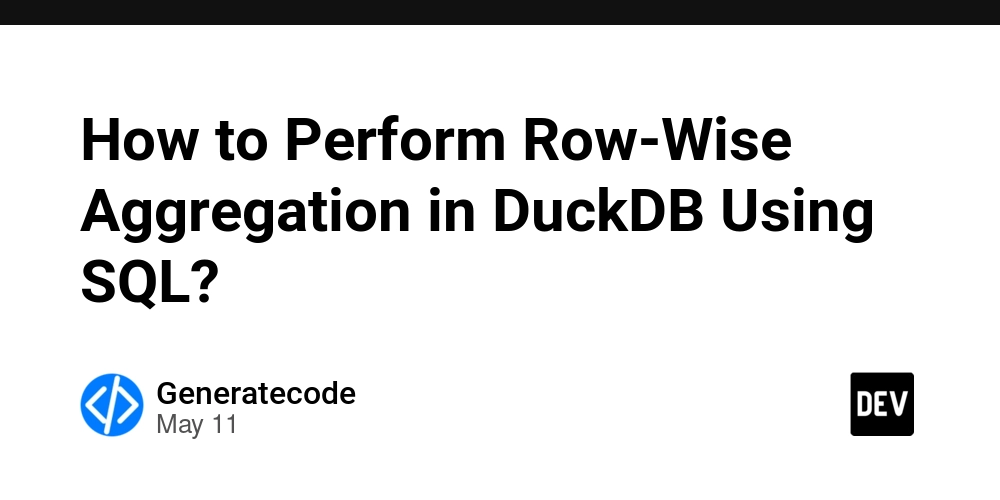How to Perform Row-Wise Aggregation in DuckDB Using SQL?
Introduction In data analysis, it's common to aggregate data from various tables. In your case, you're working with two fact tables, CDI and Population, in DuckDB. You want to perform a filtered aggregation on the Population table based on values from each row in the CDI table. This kind of task can be achieved using ANSI SQL, and I’ll walk you through how to implement it. Understanding the Tables Before diving into the SQL query, let's break down the tables you are using: CDI Table: This contains various categorical data that you'll be using as filters. Population Table: Contains population data that you'll aggregate based on the criteria defined in the CDI table. You have already successfully created your joins with the respective dimension tables, which is great. Now, let's build this filtered aggregation step-by-step. Step 1: The Base Query The query you provided successfully aggregates the population data for specific filter criteria. Here’s a recap of your base query: SELECT Year, SUM(Population) AS TotalPopulation FROM Population WHERE (Year BETWEEN 2018 AND 2018) AND (Age BETWEEN 18 AND 85) AND State = 'Pennsylvania' AND Sex IN ('Male', 'Female') AND Ethnicity IN ('Multiracial') AND Origin IN ('Not Hispanic') GROUP BY Year ORDER BY Year ASC This query calculates total population based on various filters for a given year. To perform this operation for each row in the CDI table, you can use a simple SQL JOIN. Step 2: Implementing the Row-Wise Aggregation You can take advantage of a JOIN to apply the filter dynamically based on each row of the CDI table. Below is a sample query to achieve your goal: SELECT c.Year, SUM(p.Population) AS TotalPopulation FROM CDI c JOIN Population p ON (p.Year BETWEEN c.StartYear AND c.EndYear) AND (p.Age BETWEEN c.MinAge AND c.MaxAge) AND p.State = c.State AND p.Sex IN (c.Sex1, c.Sex2) AND p.Ethnicity IN (c.Ethnicity) AND p.Origin IN (c.Origin) GROUP BY c.Year ORDER BY c.Year ASC; Explanation: c.Year: We select the year from the CDI table. SUM(p.Population): We sum the population field from the Population table. The JOIN clause connects the two tables using the filter conditions, allowing you to aggregate based on each respective row from the CDI table. You will need to ensure that the columns like StartYear, EndYear, MinAge, MaxAge, State, Sex1, Sex2, Ethnicity, and Origin are present in your CDI table. Adjust the conditions according to your actual column names. Step 3: Running the Query Execute the SQL statement in your DuckDB environment to get the aggregated population data according to the filters applied dynamically for each row in the CDI table. Tips for Optimization Indexing: Ensure that your Population table is indexed on the columns you're filtering on; this can speed up query performance significantly. Data Types: Make sure the data types match between the CDI and Population tables for effective joins. Frequently Asked Questions Q: Can I use this method with additional complexities in data? A: Yes, you can further enhance the filters or add additional tables/join as your data complexity grows. Q: What if I have more than two dimensions to filter against? A: You can add additional JOIN clauses based on extra dimension tables or just expand your current JOIN conditions to include more filters. Q: Is DuckDB performance efficient for large datasets? A: Yes, DuckDB is designed to handle analytical queries efficiently, making it a good choice for operations like these. Conclusion Aggregating data conditionally based on the rows from another table can be straightforward when using the JOIN clause effectively. With the SQL query provided, you can filter the Population data according to each row's values from the CDI table, making your analysis more versatile and insightful. Happy querying!

Introduction
In data analysis, it's common to aggregate data from various tables. In your case, you're working with two fact tables, CDI and Population, in DuckDB. You want to perform a filtered aggregation on the Population table based on values from each row in the CDI table. This kind of task can be achieved using ANSI SQL, and I’ll walk you through how to implement it.
Understanding the Tables
Before diving into the SQL query, let's break down the tables you are using:
- CDI Table: This contains various categorical data that you'll be using as filters.
- Population Table: Contains population data that you'll aggregate based on the criteria defined in the CDI table.
You have already successfully created your joins with the respective dimension tables, which is great. Now, let's build this filtered aggregation step-by-step.
Step 1: The Base Query
The query you provided successfully aggregates the population data for specific filter criteria. Here’s a recap of your base query:
SELECT Year, SUM(Population) AS TotalPopulation
FROM Population
WHERE (Year BETWEEN 2018 AND 2018) AND
(Age BETWEEN 18 AND 85) AND
State = 'Pennsylvania' AND
Sex IN ('Male', 'Female') AND
Ethnicity IN ('Multiracial') AND
Origin IN ('Not Hispanic')
GROUP BY Year
ORDER BY Year ASC
This query calculates total population based on various filters for a given year. To perform this operation for each row in the CDI table, you can use a simple SQL JOIN.
Step 2: Implementing the Row-Wise Aggregation
You can take advantage of a JOIN to apply the filter dynamically based on each row of the CDI table. Below is a sample query to achieve your goal:
SELECT c.Year, SUM(p.Population) AS TotalPopulation
FROM CDI c
JOIN Population p ON
(p.Year BETWEEN c.StartYear AND c.EndYear) AND
(p.Age BETWEEN c.MinAge AND c.MaxAge) AND
p.State = c.State AND
p.Sex IN (c.Sex1, c.Sex2) AND
p.Ethnicity IN (c.Ethnicity) AND
p.Origin IN (c.Origin)
GROUP BY c.Year
ORDER BY c.Year ASC;
Explanation:
- c.Year: We select the year from the CDI table.
- SUM(p.Population): We sum the population field from the Population table.
- The
JOINclause connects the two tables using the filter conditions, allowing you to aggregate based on each respective row from the CDI table.
You will need to ensure that the columns like StartYear, EndYear, MinAge, MaxAge, State, Sex1, Sex2, Ethnicity, and Origin are present in your CDI table. Adjust the conditions according to your actual column names.
Step 3: Running the Query
Execute the SQL statement in your DuckDB environment to get the aggregated population data according to the filters applied dynamically for each row in the CDI table.
Tips for Optimization
- Indexing: Ensure that your Population table is indexed on the columns you're filtering on; this can speed up query performance significantly.
- Data Types: Make sure the data types match between the CDI and Population tables for effective joins.
Frequently Asked Questions
Q: Can I use this method with additional complexities in data?
A: Yes, you can further enhance the filters or add additional tables/join as your data complexity grows.
Q: What if I have more than two dimensions to filter against?
A: You can add additional JOIN clauses based on extra dimension tables or just expand your current JOIN conditions to include more filters.
Q: Is DuckDB performance efficient for large datasets?
A: Yes, DuckDB is designed to handle analytical queries efficiently, making it a good choice for operations like these.
Conclusion
Aggregating data conditionally based on the rows from another table can be straightforward when using the JOIN clause effectively. With the SQL query provided, you can filter the Population data according to each row's values from the CDI table, making your analysis more versatile and insightful. Happy querying!









































































































































































![[The AI Show Episode 156]: AI Answers - Data Privacy, AI Roadmaps, Regulated Industries, Selling AI to the C-Suite & Change Management](https://www.marketingaiinstitute.com/hubfs/ep%20156%20cover.png)
![[The AI Show Episode 155]: The New Jobs AI Will Create, Amazon CEO: AI Will Cut Jobs, Your Brain on ChatGPT, Possible OpenAI-Microsoft Breakup & Veo 3 IP Issues](https://www.marketingaiinstitute.com/hubfs/ep%20155%20cover.png)






















































































































![[DEALS] 1min.AI: Lifetime Subscription (82% off) & Other Deals Up To 98% Off – Offers End Soon!](https://www.javacodegeeks.com/wp-content/uploads/2012/12/jcg-logo.jpg)














































































































































_incamerastock_Alamy.jpg?width=1280&auto=webp&quality=80&disable=upscale#)
_Brain_light_Alamy.jpg?width=1280&auto=webp&quality=80&disable=upscale#)






























































































![Nothing Phone (3) has a 50MP ‘periscope’ telephoto lens – here are the first samples [Gallery]](https://i0.wp.com/9to5google.com/wp-content/uploads/sites/4/2025/06/nothing-phone-3-telephoto.jpg?resize=1200%2C628&quality=82&strip=all&ssl=1)























































































